 He definitely isn't one of the great apes. 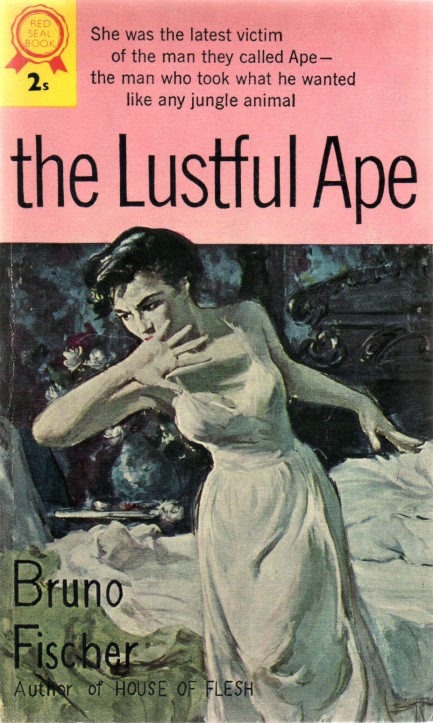
Bruno Fischer's 1950 novel The Lustful Ape has a strange title, which comes from an even stranger character, Ape Jones, so nicknamed not only because of his appearance, but due to his behavior. The protagonist, though, is a detective named Dirk Hart, whose amoral estranged wife is murdered. Explicit photos of a high society woman point to the killing being revenge for blackmail, but subplots abound as Dirk tries to solve the crime. He lives with a sister who's mixed up with the local crime lord's top henchman, has a best friend who knew his dead wife far better than he ever admitted, employs a secretary who's in love with him, and is hired by a client who commits suicide under suspicious circumstances. It's all in a day's existence for a mid-century private eye. Fischer weaves the threads together adequately and makes a readable mystery of it all, surprisingly punctuated by an extended sequence of cruel and somewhat sexualized torture. The episode makes sense, in terms of the narrative, but you don't usually come across stuff so uncompromising in tales from 1950. Our edition is from 1958 for Red Seal Books.
 Get behind me, ma'am. You'll be safe. I didn't jog and bike and do the paleo diet just to get gunned down in this stinking saloon. 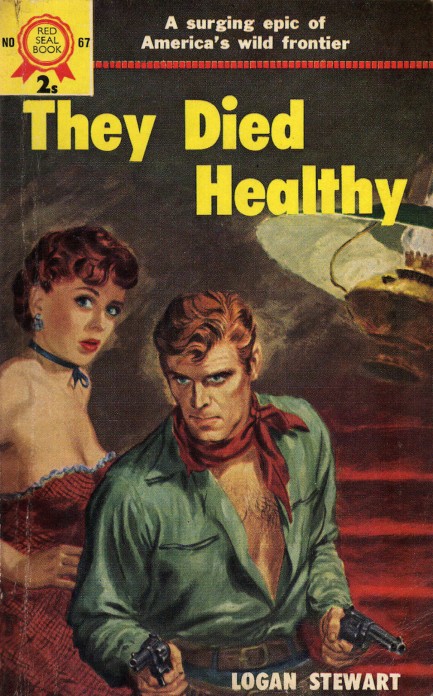
They Died Healthy is a great title for a western. Logan Stewart was actually a pseudonym for an author named Les Savage, which we think is a far better name for a writer of westerns than Logan anything. Stewart/Savage authored more than twenty books and something like ninety published stories before dying young at age thirty-five. Was he gunned down healthy? Not so much— he was in poor health for a while due to diabetes and high cholesterol before succumbing to a heart attack. But his fiction lives on. He's considered by many to be one of the better western writers of his day. They Died Healthy is copyright 1951 with art by unknown.
 I know I shouldn't laugh, but I never realized you even had a heart. 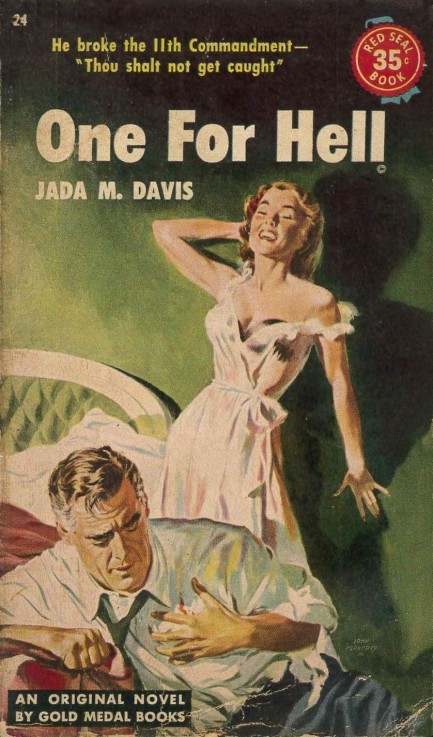
In the 1952 crime thriller One for Hell trouble comes to the fictional West Texas oil town of Breton and it arrives by train. Author Jada M. Davis tells the readers this with strong style, as various characters around town hear a sound portentous of approaching calamity but which they don't yet recognize as such. Davis writes in chapter three, “Far off, faint but clear, a train whistle mourned the passing of the night. Whoo-ooo-ooo, whoo-ooo-ooo, whooooo...”
Chapter four starts this way: The mayor heard the whistle, the whoo-ooo-oooing, shrilly whoo-ooo-oooing whistle, and sat up in bed.
Chapter five opens with this: Chief Bronson heard the whoo-ooo-oooing, whoo-ooo-OOO, whoo-ooo-oooing of the train and was glad morning was on its way.
And chapter six opens: The train whistle sounded fuzzy and dreamy to Laura Green, the whoo-ooo-ooo, whoo-ooo-ooo, whooooo-oooing-oooing lonesomely lonely and by itself.
Yes, trouble has arrived in the form of a man so bad he'll turn even the most corrupt town west of the Mississippi River upside down. He's a man who has no limits to how much he'll lie, what he'll steal, and who he'll hurt. He's a thief and a grifter. When he stumbles into a position of authority there's no thought of playing it straight. The trust he's given just means more opportunity to do wrong.
We suspect Jada Davis identified a bit with his creation, because like the author, his lead character has a name that sounds like it belongs to a woman—Willa. And he has an attitude about it, as a couple of characters find out when they comment on the fact. Willa robs stores, frames the innocent, beats women, and worse. He's racist, sexist, and destructive in ways most ’50s crime novel bad guys can't even touch. Nature or nurture? It's impossible to know.
All in all One for Hell is an effectively dark piece of entertainment, but not for the faint of heart in these days when the difference between depicting evil and endorsing it seems ever harder for people to discern. This edition came from Red Seal and it has cover art by John Floherty, Jr., who was active throughout the 1940s and 1950s. We featured another one of his covers not long ago, and you can see that here. We'll see if we can dig up more down the line.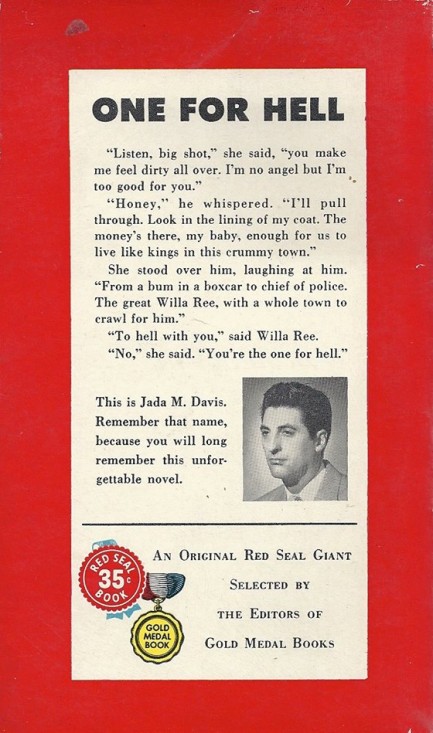
 No, I'm not going out. I just thought you'd feel better about me taking your money if I formalized the process. 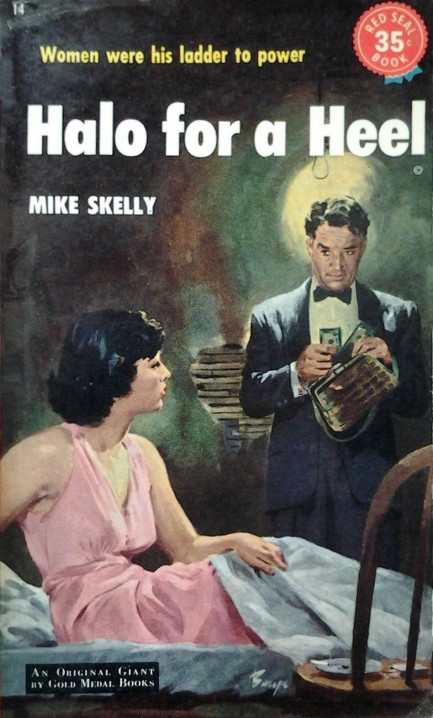
Above, Barye Phillips cover art for Mike Skelly's Halo for a Heel, 1952, from Red Seal Books. This one is about a crooked big city mayor named Danny Dolan, and the subject matter is why the cover appealed to us. Strip away all the trappings and ceremony and we think this is a fairly accurate representation of what politicians in the U.S. really do.
 If your life seems too good to be true it probably is. 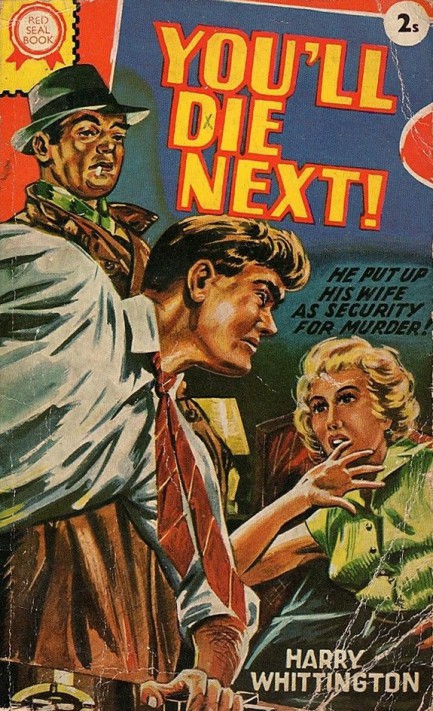
Here’s something we came across that we love. It’s a rare 1959 Red Seal edition of Harry Whittington’s thriller You’ll Die Next!, which originally was published by Ace Books in 1954. It’s the story of a solid everyman who slowly descends into a nightmare of mistaken identity—he’s punched in the face by a thug, fired from work, accused of crimes about which he has no idea, and later framed. But this unremarkable everyman has a wife so beautiful and vivacious even he could never believe she married him, and therein may lay the key to the mystery. This is considered one of Whittington’s best. Cover art is by unknown.
|
 |

The headlines that mattered yesteryear.
1945—Germany Announces Hitler's Death
German radio in Hamburg announces that Adolf Hitler was killed in Berlin, stating specifically that he had fallen at his command post in the Reich Chancery fighting to the last breath against Bolshevism and for Germany. But in truth Hitler had committed suicide along with his mistress Eva Braun, and both bodies were immediately thereafter burned. 1960—Powers Is Shot Down over U.S.S.R.
Francis Gary Powers, flying in a Lockheed U-2 spy plane, is shot down over the Soviet Union. The U.S. denies the plane's purpose and mission, but is later forced to admit its role as a covert surveillance aircraft when the Soviet government produces its remains and reveals Powers, who had survived the shoot down. The incident triggers a major diplomatic crisis between the U.S. and U.S.S.R. 1927—First Prints Are Left at Grauman's
Hollywood power couple Douglas Fairbanks and Mary Pickford, who co-founded the movie studio United Artists with Charlie Chaplin and D.W. Griffith, become the first celebrities to leave their impressions in concrete at Grauman's Chinese Theater in Hollywood, located along the stretch where the historic Hollywood Walk of Fame would later be established. 1945—Hitler Marries Braun
During the last days of the Third Reich, as Russia's Red Army closes in from the east, Adolf Hitler marries his long-time partner Eva Braun in a Berlin bunker during a brief civil ceremony witnessed by Joseph Goebbels and Martin Bormann. Both Hitler and Braun commit suicide the next day, and their corpses are burned in the Reich Chancellery garden. 1967—Ali Is Stripped of His Title
After refusing induction into the United States Army the day before due to religious reasons, Muhammad Ali is stripped of his heavyweight boxing title. He is found guilty of a felony in refusing to be drafted for service in Vietnam, but he does not serve prison time, and on June 28, 1971, the U.S. Supreme Court reverses his conviction. His stand against the war had made him a hated figure in mainstream America, but in the black community and the rest of the world he had become an icon.
|

|
|

It's easy. We have an uploader that makes it a snap. Use it to submit your art, text, header, and subhead. Your post can be funny, serious, or anything in between, as long as it's vintage pulp. You'll get a byline and experience the fleeting pride of free authorship. We'll edit your post for typos, but the rest is up to you. Click here to give us your best shot.

|
|















































































